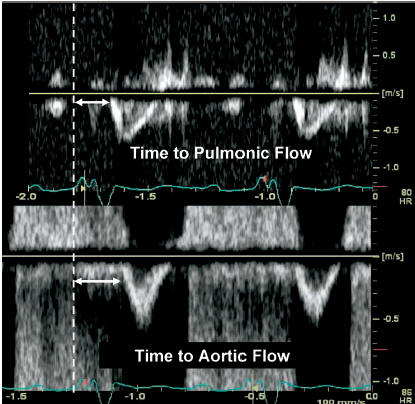|
ECHONOMY |
|
|
Diagnosis of VV Delay |
| Technique: Pulsed-wave Doppler of RVOT and LVOT flows. Normal VV Delay: VV Delay Too Long: Diagnosis of VV Delay by Echocardiography: 2. Measure time-to-onset of flow (time from onset of QRS to onset of Doppler flow) in both RVOT and LVOT 3. Calculate IVMD (the difference between RVOT and LVOT time intervals).
If
|
Timing of VV Optimization |
| For biventricular pacemakers, AV optimization
(during monochamber LV pacing) should be done before VV optimization. |
VV Optimization: Iterative Aortic Outflow Method |
|
Caveats & Notes |
|
References |
| Gorcsan J 3rd, Abraham T, Agler DA, Bax JJ,
Derumeaux G, Grimm RA, Martin R, Steinberg JS, Sutton MS, Yu CM; American
Society of Echocardiography Dyssynchrony Writing Group.
Echocardiography for cardiac resynchronization therapy: recommendations for
performance and reporting--a report from the American Society of
Echocardiography Dyssynchrony Writing Group endorsed by the Heart Rhythm
Society. J Am Soc
Echocardiogr. 2008 Mar;21(3):191-213. Barold SS, Ilercil A, Herweg B. Echocardiographic optimization of the atrioventricular and interventricular intervals during cardiac resynchronization. Europace. 2008 Nov;10 Suppl 3:iii88-95.
|


